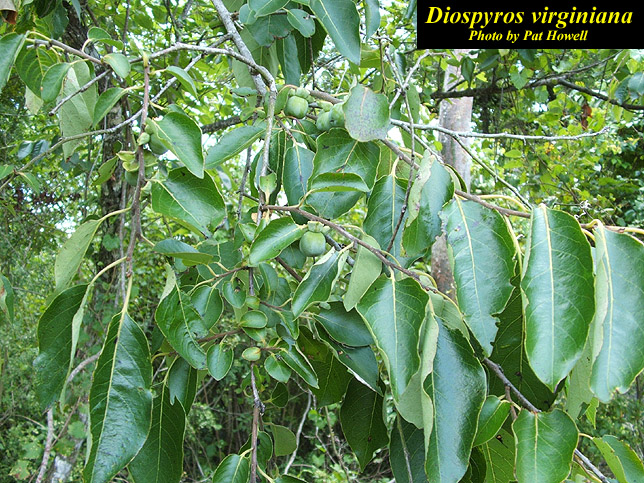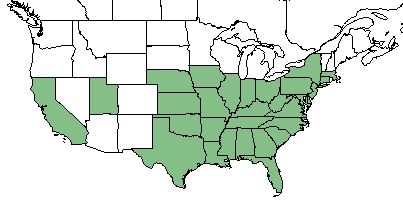Diospyros virginiana
Common Names: common persimmon[1]; American persimmon; possumwood
| Diospyros virginiana | |
|---|---|

| |
| Photo by the Atlas of Florida Plants Database | |
| Scientific classification | |
| Kingdom: | Plantae |
| Division: | Magnoliophyta - Flowering plants |
| Class: | Magnoliopsida - Dicots |
| Order: | Ebenales |
| Family: | Ebenaceae |
| Genus: | Diospyros |
| Species: | D. virginiana |
| Binomial name | |
| Diospyros virginiana L. | |

| |
| Natural range of Diospyros virginiana from USDA NRCS Plants Database. | |
Contents
Taxonomic Notes
Synonyms: D. virginiana L. var. pubescens (Pursh), D. virginiana L. var. platycarpa (Sargent), D. mosieri (Small)
The genus name Diospyros derives from the Greek name meaning fruit of the god Zeus.[2]
Description
D. virginiana is a perennial tree of the Ebenaceae family native to North America.[1] Its common name, persimmon, is of Algonquian origin.[2] The tree can reach heights of 5 to 21 meters tall, with mature bark that is thick, blocky, and dark grey in color. Leaves simple, deciduous, alternately arranged, ovate to elliptic or oblong in shape, and entire with an acuminate apex as well as a rounded base. The underside of the leaves are usually lighter-colored, more often on younger leaves. The leaves can change color to a yellow or reddish-purple in the fall. Flowers staminate or pistillate borne on separate trees located on the shoots of the current year's growth. Pistillate flowers are short-stalked or sessile, bell-shaped, fragrant, corolla greenish-yellow to creamy, and 4 lobes. Staminate flowers are borne in clusters of 2 to 3 flowers, tubularly shaped, and greenish-yellow in color. Fruit is a greenish-yellow berry that contains a highly astringent pulp before ripe, and turns a yellow-orange color when ripe with 1 to 8 flat seeds inside.[3] East from the Mississippi River, D. virginiana has cuneate to rounded leaves at the base that are glabrous or glabrescent, while D. virginiana west of the Mississippi River have subcordate leaves that are persistently pubescent. These differences could be worthy of varietal recognition.[4]
Distribution
D. virginiana is found throughout the east coast and southeastern United States as well as California and Nevada. [1] While it is sparingly in other areas, its dominant distribution is in the east-central and southeastern United States.[3]
Ecology
Habitat
D. virginiana is easily adaptable to a wide range of soils and climates; it prefers moist and well-drained soils, but can also tolerate dry, hot, and poor soils. Habitats include from dry, sterile, and sandy woodlands to rocky hillsides and river bottoms. However, best growth is usually on clay and heavy loam soil on terraces of large streams and river bottoms. In the Mississippi Delta, it grows on shallow sloughs, wet flats, and swamp margins. It is shade tolerant, but grows best in full sun. In disturbed sites, it is usually an early pioneer species, and can commonly be found along fencerows and roadsides. It can also be found to grow in thickets in pastures and open fields.[3] All soils it can grow on include sandy and sandy loam, medium loam, clay loam and clay, acid-based, and calcareous.[2] D. virginiana is considered one of the most common mid-story vegetation in the Upper Panhandle Savanna. [5] As well, a variety of habitats have been visited for samples of D. virginiana including mixed woodlands, pine wiregrass community, lowland woodlands, old field, dry sandy soils, edge of branch swamp, and sandy ridge near swamp. [6] It also grows in pine-oak-hickory forests.[7]
Associated species: Quercus laevis, Quercus chapmannii, Quercus virginiana, Quercus geminata, Pinus palustris, Pinus elliottii var. densa, Aristida sp., Ximenia americana, Cyrilla parviflora, Nyssa sylvatica, Magnolia sp., and others.[6]
Phenology
General flowering time of D. virginiana is from May to June with fruiting occurring between September and December and persisting.[4] It has been observed flowering in April and May as well.[8] Preferred fruit-bearing age is between 25 to 50 years, even though fruit can start producing on 10 year old years.[3]
Seed dispersal
This species is thought to be dispersed by consumption by vertebrates.[9] These include being eaten by various birds as well as by various mammals.[10] One study found it to disperse great distances over a wide range of elevations.[10]
Seed bank and germination
D. virginiana can germinate easily from stratified seeds, even though scarification does not seem to improve germination rates. However, clipping the caps can bring more successful germination rates by encouraging radicle emergence instead. Seeds should be stratified in moist peat for 30 to 60 days at 36 to 41 degrees.[2]
Fire ecology
Prescribed burns can be used to control the species, but fire exclusion can decrease its likelihood of surviving. As well, the roots and rootstocks of the plant can be killed with severe fires that char the soil, but less severe fires only top-kill the plant. When top-killed by fire or even cutting/pruning, vigorous sprouts produce from the root collar.[3] It seems to benefit from 3 year and 6 year burn cycles.[11]
Pollination
This plant is dioecious, meaning that male and female plants are separate individuals.[4]
Use by animals
This species consists of approximately 50-10% of the diet for large mammals, small mammals, and various terrestrial birds.[12] Bees use the nectar from the flowers for honey. White-tailed deer eat the twigs and leaves as well as the sprouts after fire or other disturbances. The fruit of the tree is eaten by squirrel, fox, skunk, deer, bear, coyote, racoon, opossum, quail, wild turkey, catbird, cedar waxwing and other various birds. Various natural defoliators of D. virginiana include the webworm (Seiarctica echo) and the hickory horned devil (Citheronia regalis).[3] This species is also an adult food source for the Luna moth (Actia luna).[2] It is an edible fruit for humans as well, known for being sweet yet can be bitter if the fruit is not fully ripe.[4] The fruit can be used to make cookies, puddings, custard, cakes, and sherbet, and the seeds can be dried, roasted, and ground to make a substitute for coffee. The wood can be used for textile shuttles and heads for driver golf clubs due to it being smooth, hard, and even textured. The inner bark and unripe fruit can be used medicinally to treat fevers, diarrhea, and hemorrhage.[3] Native American tribes also used the species to make persimmon bread, and dried the fruit for storage. This fruit was the most prized by Native Americans in the southeastern United States.[2]
Diseases and parasites
D. virginiana can be susceptible to a wilt fungus (Cephalosporium diospyri) that kills many of these trees in the southeastern United States. Individuals can become infected through small branches being severed by a twig girdler (Oncideres cingulata), where these wounds leave the plant vulnerable to infection of the wilt fungus.[3]
Conservation and Management
D. virginiana is listed as a species for special concern by the Connecticut Department of Environmental Protection, and it is listed as endangered by the New York Department of Environmental Conservation, Division of Land and Forests.[1] This species can be undesirable for growers of closely managed timber stands. For management, it can be mainly controlled by prescribed burns as well as various herbicides.[3] It is tolerant of the herbicides Dicamba, Hexazinone, and Triclopyr, and is susceptible to the herbicide Imazapyr.[13] A study found that managing areas for red cockaded woodpeckers brought an increase in frequency of D. virginiana.[14]
Cultivation and restoration
D. virginiana is a good species to utilize for erosion control due to its deep taproot. Various cultivars of this species are available, which were selected primarily for differentiating fruit taste, color, size, maturation time, and seedless cultivars.[3]
Photo Gallery
References and notes
- ↑ 1.0 1.1 1.2 1.3 USDA Plant Database
- ↑ 2.0 2.1 2.2 2.3 2.4 2.5 [[1]] Lady Bird Johnson Wildflower Center. Accessed: May 3, 2019
- ↑ 3.0 3.1 3.2 3.3 3.4 3.5 3.6 3.7 3.8 3.9 Nesom, G. and L. Moore (2006). Plant Guide: Common Persimmon Diospyros virginiana. N.R.C.S. United States Department of Agriculture. Baton Rouge, LA.
- ↑ 4.0 4.1 4.2 4.3 Weakley, A. S. (2015). Flora of the Southern and Mid-Atlantic States. Chapel Hill, NC, University of North Carolina Herbarium.
- ↑ Carr, S. C., et al. (2010). "A Vegetation Classification of Fire-Dependent Pinelands of Florida." Castanea 75(2): 153-189.
- ↑ 6.0 6.1 URL: http://herbarium.bio.fsu.edu. Last accessed: June 2018. Collectors: R.K. Godfrey, Cecil Slaughter, Loran Anderson, T.Lott, B. Lund, Tom Barnes, Richard Mitchel, Gary Knight, Patricia Elliot, Bruce Hansen, Anne Perkins, Gwynn Ramsey, Karen MacClendon, M. Boothe, Leon Neel, Richard Gaskalla, R. Komarek, A. Johnson, M, Jenkins, Richard Carter. States and counties: Florida (Marion, Massau, Liberty, Franklin, Leon, Alachua, Wakulla, Highlands, Hernando, Jackson, Taylor, Collier, Lee, Sarasota, Gadsden, Suwannee, Calhoun, Washington, Holmes, Gulf) Georgia (Thomas, Grady, Lee)
- ↑ Bostick, P. E. (1971). "Vascular Plants of Panola Mountian, Georgia " Castanea 46(3): 194-209.
- ↑ Nelson, G. PanFlora: Plant data for the eastern United States with emphasis on the Southeastern Coastal Plains, Florida, and the Florida Panhandle. www.gilnelson.com/PanFlora/ Accessed: 21 MAY 2018
- ↑ Kirkman, L. Katherine. Unpublished database of seed dispersal mode of plants found in Coastal Plain longleaf pine-grasslands of the Jones Ecological Research Center, Georgia.
- ↑ 10.0 10.1 Battaglia, L. L., et al. (2002). "Sixteen years of old-field succession and reestablishment of a bottomland hardwood forest in the lower Mississippi alluvial valley." Wetlands 22(1): 1-17.
- ↑ Cain, M. D., et al. (1998). "Prescribed fire effects on structure in uneven-aged stands of loblolly and shortleaf pines." Wildlife Society Bulletin 26: 209-218.
- ↑ Yarrow, G.K., and D.T. Yarrow. 1999. Managing wildlife. Sweet Water Press. Birmingham.
- ↑ (2000). The role of fire in nongame wildlife management and community restoration: Traditional uses and new directions, Nashville, TN, USDA Forest Service, Northeastern Research Station.
- ↑ Bowman, J. L., et al. (1999). Effects of red-cockaded woodpecker management on vegetative composition and structure and subsequent impacts on game species. Proceedings of the Fifty-third Annual Conference, Southeastern Association of Fish and Wildlife Agencies. A. G. Wong, P. Doerr, D. Woodward, P. Mazik and R. Lequire. Greensboro, NC, Southeastern Association of Fish and Wildlife Agencies: 220-234.